February 2022
- English
- 日本語
“The Station on the Lake”: Okuoi Kozyo Station on the Oigawa Railway’s Ikawa Line
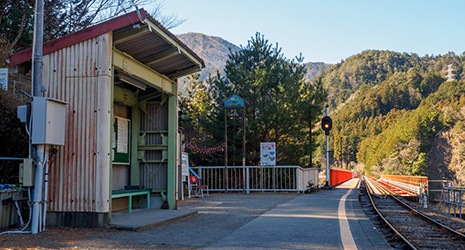
Okuoi Kozyo Station 
Okuoi Kozyo Station viewed from the observation deck on the opposite bank of the lake
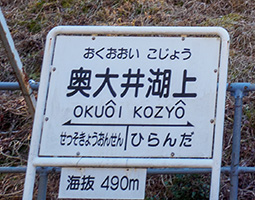
Okuoi Kozyo Station platform sign 
A promenade for pedestrians runs parallel to the tracks on the bridge across the lake 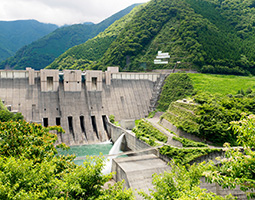
Nagashima Dam, which led to the formation of Sesso Lake 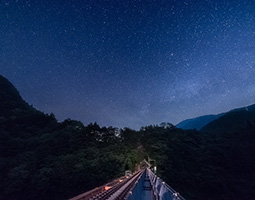
The starry sky over the Okuoi Kozyo Station bridge 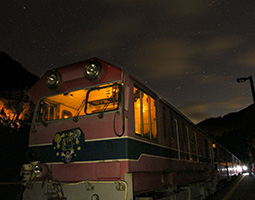
The Starry Sky Train

A remote station on the Oigawa Railway’s Ikawa Line attracts many people to its scenic location in the middle of a lake.

The Oi River (Oigawa), a Class A river* that flows through central Shizuoka Prefecture on the Pacific coast in the middle of Honshu, has its source in 3,000-meter-high mountains and flows 160 kilometers before emptying into Suruga Bay. Running alongside the Oi River in this remote mountainous area is the Oigawa Railway’s Ikawa Line, a 25.5 km line known for its many tunnels and bridges, and for its magnificent views.
The Ikawa Line runs from Senzu Station to Ikawa Station and has fourteen stations in all. Okuoi Kozyo Station, which is a little over an hour’s ride from Senzu Station, is an especially popular stop on the line and is known as “the station on the lake.” In fact, the station is located at the tip of a peninsula that juts out into Sesso Lake, an artificial lake created after the construction of a dam. This section of the Ikawa Line became submerged, so the 70-meter-high Oku-oi Rainbow Bridge was built over the lake with the peninsula at its halfway point. Viewed from the observation deck on the opposite bank of the lake, the contrast between the deep green lake surface and the red iron bridge is vivid and impressive.

Okuoi Kozyo Station opened on the peninsula in 1990. Niibori Eri of the Oigawa Railway Corporate Planning Office says, “Currently, there are no houses in the vicinity and most of the people using the station come just to see it.”
Okuoi Kozyo Station became famous in Japan about ten years ago when the superb views from the station and the beautiful colors of nature surrounding it were featured in a TV program. After that, more and more people posted pictures of it on Instagram and it became popular as an “Instagrammable place.” Then, in 2019, Okuoi Kozyo Station became the first location in Shizuoka Prefecture to be awarded the COOL JAPAN AWARD by the COOL JAPAN Council, which has foreign examiners from all over the world certify COOL JAPAN that has global appeal. This attracted international attention, and since it was before the spread of COVID-19, the number of foreign tourists increased for a while.

“The observation deck on the opposite bank to the station can be reached in about 15 minutes after crossing the bridge,” says Niibori. “The view from there is truly majestic. The appearance of the mountains changes with the seasons and the color of the water has infinite variety. You never tire of seeing the threefold harmonious view of rugged mountain gorge terrain, skyline uninterrupted by human-built structures, and the deep shades of the lake.”

As a remote mountainous location with no houses or other sources of light pollution**, the station area is ideal for stargazing. To take advantage of this, Oigawa Railways is running a special “Starry Sky Train” every Saturday and Sunday, except at the beginning of the year, for a limited time from November in 2021 to February in 2022.

“The train arrives at Okuoi Kozyo Station shortly after 6 pm, from when passengers can observe the starry sky for nearly an hour. It’s a cold time of year, but the stars shine that much brighter, so astronomy fans love it,” says Niibori.

Day and night, many people are attracted to remote Okuoi Kozyo Station and its wonderful views.
* River systems deemed important for the national economy and people’s lives are designated as “Class A river systems” (MLIT)
** Light pollution is artificial skylight (as from city lights) that interferes especially with astronomical observations.

